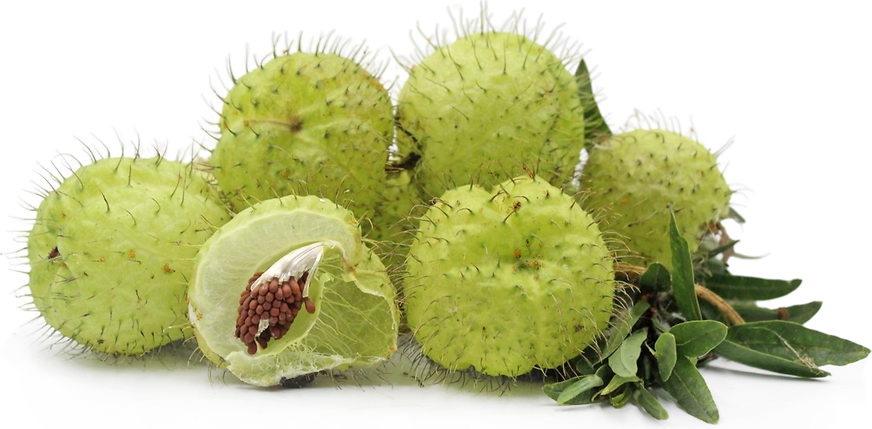


Balloon Cotton-Bush Fruit
Estimated Inventory, lb : 0
Description/Taste
Balloon Cotton-Bush is a shrub-like plant growing from a single-stemmed trunk, expanding into hollow, pale yellow-green branches. Each branch is covered in light green, lanceolate-shaped leaves ranging from 7 to 10 centimeters in length and produces clusters of small drooping flowers in the spring. The flowers have five curved waxy petals that bend backward and release a light vanilla-like aroma, and the blooms are primarily white with small touches of pink or purple in the center. After the flowers bloom, spherical pale green fruits, known as follicles, develop, inflating and expanding into a bulbous, globular ball. Each follicle averages 5 to 7 centimeters in length and 4 to 6 centimeters in diameter and has thin, delicate, and easily punctured skin. The follicle is also covered in soft brown spines, giving the surface a hairy appearance. As the follicle matures, it transitions into yellow, red, or brown hues and will eventually split open, releasing tiny brown seeds attached to a slender tuft of white hair. These hairs allow the seeds to float through the wind and settle long distances away from the parent plant. All parts of the Balloon Cotton-Bush plant contain a milky white latex that is considered poisonous if consumed. The plant is deemed ornamental, not edible, and is sometimes used in topical treatments in natural medicines.
Seasons/Availability
Balloon Cotton-Bush blooms in the spring and summer and produces spherical follicles in the late summer through winter.
Current Facts
Balloon Cotton-Bush plants, botanically classified as Gomphocarpus physocarpus, are a type of milkweed belonging to the Apocynaceae family. The herbaceous shrub grows 1 to 3 meters in height and is native to South Africa, where the plant is still found growing wild and cultivated in home gardens. Balloon Cotton-Bush has been spread and naturalized worldwide over time and is known by many names, including Balloon Milkweed, Globito, Monkey Balls, Elephant Balls, Hairy Balls, and Bindweed. Many of these names were given in reference to the plant’s inflated balloon-like follicles. The plant’s botanical classification also describes the follicles, as the term physocarpus stems from the Greek word “physa,” meaning “bladder,” and “karpos,” meaning “fruit.” Balloon Cotton-Bush is not a culinary plant as it contains a milky white latex that is considered toxic if ingested, but the follicles, seeds, and flowers are viewed as highly ornamental, used for decorative purposes, and in natural medicines.
Nutritional Value
Balloon Cotton-Bush has not been studied for its nutritional properties as the follicles are not commonly consumed. In natural medicines, especially in South Africa, Balloon Cotton-Bush leaves are used for their milky latex and are applied topically on warts, boils, and skin irritations. A mixture of dried leaves and honey is also made into a paste and massaged into the lower back to relieve pain. In addition to topical applications, Balloon Cotton-Bush roots are sometimes used to reduce stomach pain, while dried leaves are ground into a powder and inhaled to relieve headaches. In Lesotho, dried Balloon Cotton-Bush leaves and flowers are ground into a powder and used as a gauge for the severity of illness in patients. According to superstition, if the patient does not sneeze after inhaling the powder, they are beyond medicinal help.
Applications
Balloon Cotton-Bush is not consumed in culinary preparations as the plant contains a milky latex that is considered toxic if ingested. Though commonly referred to as a fruit, the inflated follicles are utilized as an ornamental decoration rather than a culinary ingredient. Some research mentions that the Maasai people of Tanganyika may eat the fruit, but no explanation or details were given to render this statement factual. Balloon Cotton-Bush follicles grow on long stems that can be removed from the plant and interwoven into floral arrangements. The follicles have a striking, unusual appearance, adding texture, color, and shape as a centerpiece. They can also be incorporated fresh or dried, holding their shape well, and will last for several days in floral arrangements. Beyond flower arrangements, parts of the Balloon Cotton-Bush plant are used in Somalia to create string and fabric fibers. The string is traditionally used to construct snares, while the fibers are spun into a cotton-like material used to make belts. In Lesotho, the cottony-white tufts are stuffed into pillows for a soft, light feel.
Ethnic/Cultural Info
Balloon Cotton-Bush is an important food source for the African monarch butterfly. Eggs are laid on the plant’s leaves, and once the larvae hatch, they stay on the shrub until they emerge from their cocoons after metamorphosis. Balloon Cotton-Bush provides food and shelter for the growing caterpillars. The caterpillars are also immune to the toxins in the plant’s latex, but their body still absorbs the toxins, creating an unpleasant flavor if the caterpillar is eaten. This flavor repels potential predators and protects the caterpillars until they can transform into butterflies. The African monarch butterfly is believed to be one of the first species of butterfly to be depicted in art, appearing in ancient Egyptian paintings.
Geography/History
Balloon Cotton-Bush is native to tropical Africa and has been growing wild since ancient times. The shrubs were later spread to South Africa in the early ages and became widely naturalized over time in tropical, subtropical, to warm temperate climates worldwide. The plants are typically found growing along riverbanks, in grasslands, along roadsides, fields, and in moisture-rich soil, and they are also planted in home gardens as an ornamental variety. Today Balloon Cotton-Bush can be seen in Africa and South Africa, Madagascar, China, India, South and Central America, Mexico, in the midwestern United States, and in the Mediterranean. The plant is also viewed as an invasive weed in Hawaii, Australia, some areas of the Caribbean, and French Polynesia. Balloon Cotton-Bush is not commercially grown and is rarely found in markets. The follicles can occasionally be found through local vendors as a decorative or medicinal plant.




